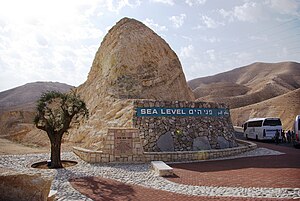
Back Seevlak Afrikaans Livel d'a mar AN مستوى سطح البحر Arabic Nivel de la mar AST Dəniz səviyyəsi Azerbaijani دنیز سطحی AZB Диңгеҙ кимәле Bashkir Узровень мора Byelorussian Морско равнище Bulgarian समुंद्र तल Bihari

Mean sea level (MSL, often shortened to sea level) is an average surface level of one or more among Earth's coastal bodies of water from which heights such as elevation may be measured. The global MSL is a type of vertical datum – a standardised geodetic datum – that is used, for example, as a chart datum in cartography and marine navigation, or, in aviation, as the standard sea level at which atmospheric pressure is measured to calibrate altitude and, consequently, aircraft flight levels. A common and relatively straightforward mean sea-level standard is instead a long-term average of tide gauge readings at a particular reference location.[1]
Sea levels can be affected by many factors and are known to have varied greatly over geological time scales. Current sea level rise is mainly caused by human-induced climate change.[2] When temperatures rise, mountain glaciers and polar ice sheets melt, increasing the amount of water in the oceans, while the existing seawater also expands with heat. Because most of human settlement and infrastructure was built in response to a more-normalized sea level with limited expected change, populations affected by sea level rise will need to invest in climate adaptation to mitigate the worst effects or, when populations are at extreme risk, a process of managed retreat.[3]
The term above sea level generally refers to the height above mean sea level (AMSL). The term APSL means above present sea level, comparing sea levels in the past with the level today.
Earth's radius at sea level is 6,378.137 km (3,963.191 mi) at the equator. It is 6,356.752 km (3,949.903 mi) at the poles and 6,371.001 km (3,958.756 mi) on average.[4] This flattened spheroid, combined with local gravity anomalies, defines the geoid of the Earth, which approximates the local mean sea level for locations in the open ocean. The geoid includes a significant depression in the Indian Ocean, whose surface dips as much as 106 m (348 ft) below the global mean sea level (excluding minor effects such as tides and currents).[5]
- ^ What is "Mean Sea Level"? Liverpool, UK: National Oceanography Centre. Retrieved 29 January 2024.
- ^ USGCRP (2017). "Climate Science Special Report. Chapter 12: Sea Level Rise. Key finding 1". science2017.globalchange.gov: 1–470. Archived from the original on 8 December 2019. Retrieved 27 December 2018.
- ^ Nicholls, Robert J.; Marinova, Natasha; Lowe, Jason A.; Brown, Sally; Vellinga, Pier; Gusmão, Diogo de; Hinkel, Jochen; Tol, Richard S. J. (2011). "Sea-level rise and its possible impacts given a 'beyond 4°C (39.2°F)world' in the twenty-first century". Philosophical Transactions of the Royal Society of London A: Mathematical, Physical and Engineering Sciences. 369 (1934): 161–181. Bibcode:2011RSPTA.369..161N. doi:10.1098/rsta.2010.0291. ISSN 1364-503X. PMID 21115518. S2CID 8238425.
- ^ "Earth Radius by Latitude Calculator". Archived from the original on 15 August 2021. Retrieved 22 August 2021.
- ^ Sreejith, K.M.; Rajesh, S.; Majumdar, T.J.; Rao, G. Srinivasa; Radhakrishna, M.; Krishna, K.S.; Rajawat, A.S. (January 2013). "High-resolution residual geoid and gravity anomaly data of the northern Indian Ocean – An input to geological understanding". Journal of Asian Earth Sciences. 62: 616–626. Bibcode:2013JAESc..62..616S. doi:10.1016/j.jseaes.2012.11.010.